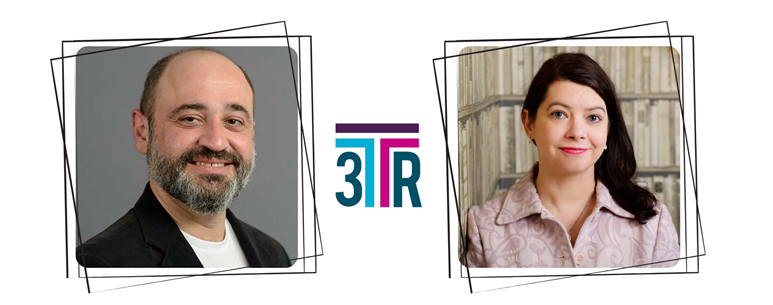Mission of 3TR project inspires researchers and patients

In this month's blog, we are pleased to publish a Q&A with two individuals who are involved with the 3TR initiative, an EU-funded public-private partnership project under the IMI umbrella. SBI Group Leader, Dr David Gomez Matallanas, currently does research on a 3TR-funded sub-project. Joan Jordan is a EUPATI Fellow and a patient advocate for Multiple Sclerosis, taking part in the 3TR project as a lay person. Both David and Joan are keen to communicate the importance of 3TR and its impact in both research and public engagement for a variety of diseases.
According to the project website, 3TR "sets out to fundamentally increase our knowledge of the molecular pathways and mechanisms linked to response and non-response to therapy in seven different immune-mediated, allergic and inflammatory diseases." The diseases are chronic obstructive pulmonary disease, asthma, Crohn’s disease, ulcerative colitis, multiple sclerosis, systemic lupus erythematosus and rheumatoid arthritis which affect millions of people around the globe. 3TR aims to support research that will lead to a deeper understanding of the molecular mechanisms behind these diseases and hopefully "identify novel biomarkers leading to improved patient management and personalised therapy." SBI's involvement with 3TR began in 2019, with researchers providing integration of omics data and generation of personalised molecular patient profiles to the project.
Q: The mission of 3TR is "Right Drug. Right Patient. Right Time." David, how does the mission shape the work you are doing in SBI and which of the seven illnesses in 3TR's remit do you study?
A: The short answer is that we will be working on all of the diseases as this is the final goal of 3TR. Thus, the mission of 3TR is at the center of what we are doing in SBI in particular and in the bioinformatic group of 3TR that we are part of.
To understand and explain what we do it is probably necessary to explain the concept behind the project in more common terms. This is a large consortium that focuses on the study of seven chronic diseases that in principle have very different symptoms, treatments and outcomes but in all cases, we know that the immune system is not working properly. These diseases were traditionally studied independently but the idea behind the project is that they all share common mechanisms that cause the disease. If we identify these common points, we can then try to develop new treatments that can be used to treat many of all of the seven diseases. To do this, in 3TR we have a very big consortium that brings together clinicians who treat the patients and collect samples that are used in the study, lab researchers who perform analysis and experiments, companies that develop treatments for the diseases and computational researchers who use computers to try to get the most information from the data that is generated in the project.
In SBI, we are involved in the computational analysis and our objective is to first identify the molecular mechanisms that are altered in each disease and then integrate all this information to identify the things that are common to all the diseases. With this information, the expectation is that other partners in the project can develop better treatments for the patients and most likely we can develop specific treatments for a group of patients, which is known as personalised medicine. In our case, we are currently analysing data already available for lupus and we are now getting data from the other diseases.
Q: Joan, can you tell us a bit about why 3TR is important to you and what drew you to get involved?
A: At 21, I reported my first symptoms to a doctor, but did not get diagnosed with Multiple Sclerosis until 14 years later. I had the best of care but did not get sent for an MRI -- which would have meant that I could have started treatment earlier -- perhaps preventing additional lesions. Subsequent to diagnosis, I felt that I waited a long time to be put on medication and it was a "first line, second line, third line approach" with not much personalisation or intelligence involved. While I could feel bitter about this, I realise that I cannot change the past. 3TR aims to "support research that will lead to a deeper understanding of the molecular mechanisms behind diseases" like MS and hopefully "identify novel biomarkers leading to improved patient management and personalised therapy." Nobody has more skin in the game than these future patients. I got involved because I want them to have better outcomes.
Q: David, how do you feel the research-led approach to partnership initiatives such as 3TR benefits the patients?
A: I think that the more we know about what causes a disease and what goes wrong in a specific patient or group of patients, the more chances we have to get better ways of treating the patients. The information that we will get from 3TR will hopefully lead to new clinical trials and treatments. But as we are also analysing data that the academic and industry partners already have, we can make new discoveries from previous studies. Importantly, many patients want to know as much as possible about their disease and the research that is being done to improve the patient's quality of life, so any finding that goes in that direction is important for them. I think that the fact that the patient organisations are part of the consortium and play an important role in informing the public of what is found in 3TR is already benefiting many patients.
Q: Joan, you have mentioned that you were a participant in a research project which resulted in a white paper. Can you tell us a bit more about this?
A: Sure! It's called PRioRiTy I and II (https://priorityresearch.ie/
Q: As you know, David, SBI does a lot of cancer-focused research, while 3TR is focused on immune-mediated, allergic and inflammatory diseases. Do you see ways in which the research being done in SBI can be beneficial to both areas?
A: Yes, that is why we got involved in the project. In SBI we have developed many tools to analyse complex data and understand the mechanisms that control normal cells and how, when these mechanisms are broken, it can lead to cancer development. These tools can be used for other diseases with similar problematic molecules to those in cancer, and that is what we are doing here. From the point of view of cancer research, we now know that the immune system plays an important role in the prevention of cancer and we can learn a lot from studying the seven diseases that are the focus of 3TR.
Q: At the moment, the patient side of 3TR is still in its infancy. Joan, where would you like to see this aspect of the project go in the future?
A: Ultimately, I would like to see the right patients getting the right drug at the right time. The concept of a "Super-Responder" is fascinating. If more targeted prescribing could be implemented, our quality of life will improve. I am certain that people living with diseases will be more than happy to contribute -- not just by donating samples, but by getting meaningfully involved in every phase of the project. A lot of work is being done on 3TR with patients in the respiratory part and we would like to see this replicated across the different disease areas. Finding out what patient thinks truly makes a responder or non responder is so important.
Q: Does 3TR have a project end date, or will it keep going indefinitely?
A: The project started in 2019 and is for seven years so we are halfway through. But the data and findings produced in the project will be available for the scientist and companies to use after the conclusion of the project. For sure there will be follow up projects that will continue the work done in 3TR. I think that the real end date should be when we have effective treatments for all the patients of the seven diseases.
Q: How can people - either in research or public/patient engagement - get involved with the 3TR initiative?
A: From the research point of view individual scientists may apply to some of the positions that are or will be available within the consortium and contribute to the work done. For patients, they should get in touch with the European Lung Foundation (info@europeanlung.org). ELF are running the patient group that inputs into the work around asthma and COPD. They also are trying to support better patient involvement across the project, working with people with fantastic lived experience like Joan. You can also sign up for the 3TR newsletter or look at the 3TR website.
For more information:
- SBI News, October 2019 - 3TR: SBI joins 69 European partners in largest-ever Innovative Medicine Initiative 2 (IMI2) immunology project
- 3TR Website
This project has received funding from the Innovative Medicines Initiative 2 Joint Undertaking (JU) under grant agreement No 831434.
The JU receives support from the European Union’s Horizon 2020 research and innovation programme and EFPIA.
The content of this blog reflects only the author's view and the JU is not responsible for any use that may be made of the information it contains.

